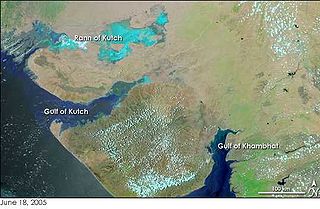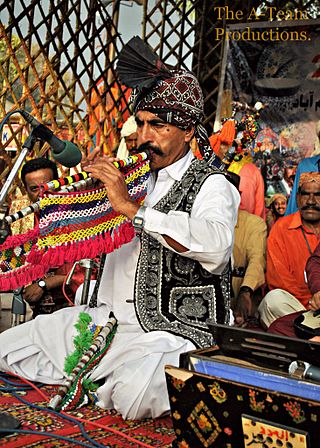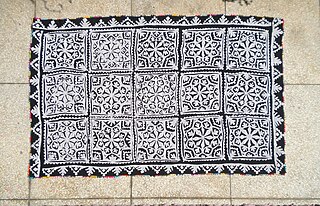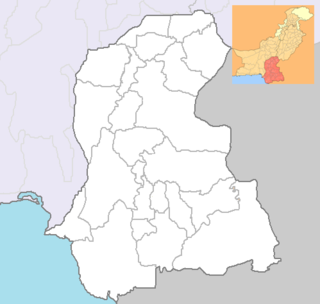
Sindh is a province of Pakistan. Located in the southeastern region of the country, Sindh is the third-largest province of Pakistan by land area and the second-largest province by population after Punjab. It is bordered by the Pakistani provinces of Balochistan to the west and north-west and Punjab to the north. It shares an International border with the Indian states of Gujarat and Rajasthan to the east; it is also bounded by the Arabian Sea to the south. Sindh's landscape consists mostly of alluvial plains flanking the Indus River, the Thar Desert of Sindh in the eastern portion of the province along the international border with India, and the Kirthar Mountains in the western portion of the province.

Sindhis are an Indo-Aryan ethnolinguistic group, originating from and native to the Pakistani province of Sindh, who share a common Sindhi culture, history and language. The historical homeland of Sindhis is bordered by the southeastern part of Balochistan, the Bahawalpur region of Punjab and the Kutch region of Gujarat.

The pungi, bīn or Murli is a musical instrument that originates from the Indian subcontinent. The instrument consists of a reservoir into which air is blown and then channelled into two reed pipes. It is played with no pauses, as the player employs circular breathing. In street performances, the pungi is used for snake charming.

The Great Rann of Kutch is a salt marsh in the Thar Desert in the Kutch District of Gujarat, India. It is about 7500 km2 in area and is reputed to be one of the largest salt deserts in the world. This area has been inhabited by the Kutchi people.
Lohana are a trading or mercantile jāti mostly in India and also in Pakistan.

Alghoza also called Beenon is a paired woodwind traditional musical instrument of Sindhi culture, also used by Kutchi, Saraiki, Punjabi, Rajasthani and baloch folk musicians. It consists of two joined beak flutes, one for melody, the second for drone. The flutes are either tied together or may be held together loosely with the hands. A continuous flow of air is necessary as the player blows into the two flutes simultaneously. The quick recapturing of breath on each beat creates a bouncing, swinging rhythm. The wooden instrument initially comprised two flute pipes of the same length but over time, one of them was shortened for sound purposes. In the world of Alghoza playing, the two flute pipes are a couple — the longer one is the male and the shorter one the female instrument. With the use of beeswax, the instrument can be scaled to any tune.

Jadeja is a Samma Rajput clan that inhabits the Indian state of Gujarat and the Tharparkar district of Sindh, Pakistan. They originated from Sammas of Sindh, a pastoral group, and laid a claim on the Rajput identity after marriages with Sodha Rajput women by adopting a process called Rajputisation.

Shah Jo Risalo is a book of poems of the Sindhi Sufi poet Shah Abdul Latif Bhittai. Shah Abdul Latif's poetry was transmitted orally during his lifetime and compiled after his death and designated as Shah Jo Risalo or Poetry of Shah.

The history of Sindh refers to the history of the modern-day Pakistani province of Sindh, as well as neighboring regions that periodically came under its sway.

Ralli,Rilli or Rillki quilts are traditional quilts of Sindh, in southeastern Pakistan, and the surrounding regions bordered by the southeastern part of Balochistan, the Bahawalpur region of Punjab, Rajasthan and the Kutch region of Gujarat. Traditionally, they were made of cotton, but synthetic fabrics have increasingly been used since the late 1900s. The types, colors, and designs of ralli quilts vary depending upon the area in which they are made. There are different types of ralli making, three of which are widely known. These include appliqué, patchwork, and embroidered ralli. All rallis are handmade by women artisans of Sindh's remote areas. Embroidery designs and motifs indicate perceived on painted pottery from the area's ancient civilizations. Mothers used to explain several inheritance patterns to their daughters.
Sindhi folk music is traditional folk music and singing from Sindh, which is sung and generally performed in 5 genres that originated in Sindh, the first genre "Bait" styles. The Bait style is vocal music in Sanhoon and Graham. Second style "Waee" instrumental music is performed in a variety of ways using a string instrument. Waee, also known as Kafi. Sindhi folk music was popularized by great Sindhi sufi poet Shah Abdul Latif Bhitai.

Ajrak, also known as Ajrakh, is a unique form of textile block-printing found primarily in Sindh, Pakistan and the village of Ajrakhpur in the bordering Kutch district of India. Ajrak textiles like shawls or dresses display special designs and patterns made using block printing with stamps. Ajrak is a symbol of Sindhi culture and traditions. Ajrak prints are also famous in neighbouring areas of India, in Gujarat, due to their influence from the Indus Valley civilization. Apart from Sindh and Kutch, recently, a Saraiki version of the Ajrak called Sajarak was created and is found in South Punjab, Pakistan.
Nabi Bakhsh Khan Baloch was a Sindhi research scholar, historian, sindhologist, educationist, linguist and writer. He predominantly wrote in Sindhi, including Urdu, English, Persian and Arabic. He has been described as the "moving library" of the Pakistani province of Sindh.

The Culture of Sindh has its roots in the Indus Valley civilization. Sindh has been shaped by the largely desert region, the natural resources it has available, and continuous foreign influence. The Indus or Sindhu River, which passes through the land, and the Arabian Sea also supported the seafaring traditions among the local people. The local climate also reflects why the Sindhis have a language, folklore, traditions, customs, and lifestyle that are so different from the neighbouring regions. The Sindhi culture is also practised by the Sindhi diaspora.
Ustad Muhammad Juman was a Sindhi musician and classical singer from Pakistan, whose impact on Sindhi music is still pervasive.
Sindhi folktales play an important part in the culture of the Sindhi people of southern Pakistan. Pakistan's Sindh province abounds in fairy-tales and folktales that form its folklore. Some of these folktales are particularly important for the development of higher literature in Sindhi, since they were to form the core of mystical tales of Sindh immortalized by Shah Abdul Latif Bhittai, and are generally known as Heroines of Shah.

Sorath Rai Diyach is a romantic folktale in Sindhi and Gujarati folklore. The story also appears in Shah Jo Risalo and forms part of seven popular tragic romances from Sindh. The other six tales are Umar Marvi, Sassui Punnhun, Sohni Mehar, Lilan Chanesar, Noori Jam Tamachi and Momal Rano commonly known as the Seven Queens of Sindh, or the Seven heroines of Shah Abdul Latif Bhittai.

Sindhi clothing are a part of the Sindhi culture. Sindhi women and men wear the Shalwar Qameez or the Kurta with Pyjama. Women also wear Sari or ghagra. However, before the adoption of the Shalwar kameez, kurta, the Sari as well as other articles of clothing, Sindhis had their own traditional costumes.

The Sketches is a Sufi folk rock band from Jamshoro, Sindh, Pakistan, created by young musician Saif Samejo. "Sindhi melody is very charming; there is enormous flexibility of words" says Saif Samejo. Their motherland has always been a major inspiration which is portrayed in their work. The love for their language and culture is aimed to bring back the departed old identity and to produce quality work in order to sensitize the world in general and the youth in specific about the grace of Sindhi language.

Lakho Phulani, (Sindhi: لاکو ڦلاڻي, born in 920 A.D at ) also known as Lakho Fulani or Lakho Phoolani, was a notable historical character who ruled parts of Sindh, Kutch and Saurashtra. who in Sindh, struggled to establish a permanent and stable government of the Sindhis. He was ruler of Sind in 10th century. Dr. Nabi Bakhsh Baloch writes: Sindh's Lakho Phulani made big raids on the Gujarat side and defeated the violent people forever. For those who began the process of mutilation, it was historically valid. Atkot is a historical town, said to have been settled by Lakho Phulani. He also built Lakheshwar temple in Kera, Kutch.














